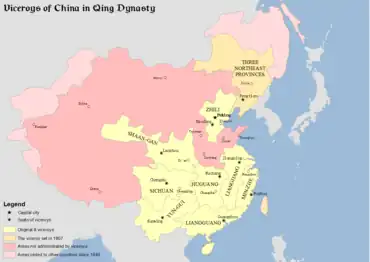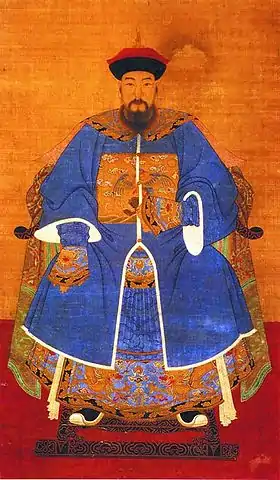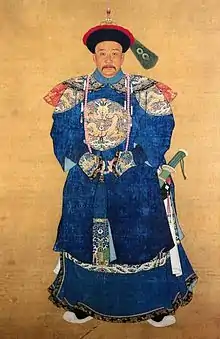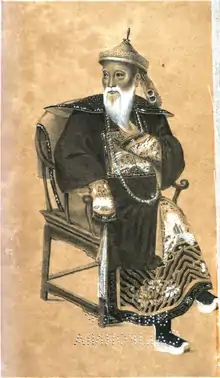
| Viceroy of Shaan-Gan | |||||||
|---|---|---|---|---|---|---|---|
| Chinese name | |||||||
| Traditional Chinese | 陝甘總督 | ||||||
| Simplified Chinese | 陜甘总督 | ||||||
| |||||||
| Governor-General of Shaanxi, Gansu and Other Local Areas, in Charge of Military Affairs, Food and Wages, Tea and Horses and Governor Affairs | |||||||
| Traditional Chinese | 總督陝甘等處地方提督軍務、兼理糧餉、管理茶馬、兼巡撫事 | ||||||
| Simplified Chinese | 总督陕甘等处地方提督军务、兼理粮饷、管理茶马、兼巡抚事 | ||||||
| |||||||
| Manchu name | |||||||
| Manchu script | ᡧᠠᠨᠰᡳ ᡬᠠᠨᠰᡠ ᡳ ᡠᡥᡝᡵᡳ ᡴᠠᡩᠠᠯᠠᡵᠠ ᠠᠮᠪᠠᠨ | ||||||
| Romanization | šansi gansu i uheri kadalara amban | ||||||
The Viceroy of Shaan-Gan, fully in Chinese as the Governor-General of Shaanxi, Gansu and Other Local Areas, in Charge of Military Affairs, Food and Wages, Tea and Horses and Governor Affairs, was one of eight regional Viceroys during the Qing dynasty. The Viceroy of Shaan-Gan had jurisdiction of military, civil, and political affairs over then Shaanxi Province and then Gansu Province.
Name

The name Shaan-Gan is derived by taking the first characters of the province names Shaanxi and Gansu.
History
Ming dynasty
The office of Viceroy of Shaan-Gan originated in the early Ming dynasty with the garrisoning of military forces in three towns along the northern border of Shaanxi Province. The three garrisons were called "Xunfu of Yansui" (延綏巡撫), "Xunfu of Ningxia" (寧夏巡撫) and "Xunfu of Gansu" (甘肅巡撫), respectively.
In 1497, when the Mongols of the Northern Yuan dynasty made intrusions across the border, the Hongzhi Emperor put Wang Yue (王越) in charge of coordinating military actions in Shaanxi, Yansui, Ningxia and Gansu.
In the early reign of the Zhengde Emperor (r. 1505–1521), the Mongols invaded Guyuan. The general Cao Xiong (曹雄) rejected external help from reinforcements. Yang Yiqing (楊一清) led lightly armed cavalry to launch a surprise attack on the Mongols and succeeded in driving them back. After this incident, Yang Yiqing realized that military operations in Yansui, Ningxia and Gansu had to be better coordinated, hence he urged the imperial court to appoint a viceroy to oversee the three areas. Liu Daxia (劉大夏) nominated Yang Yiqing for that position.
The office of the viceroy was created in 1525, during the reign of the Jiajing Emperor, under the name "tidu of military affairs" (提督軍務). The office was renamed to "zongzhi" (總制) in 1528, and to "zongdu" (總督) in 1540. The headquarters were located at Huamachi (花馬池; present-day Yanchi County, Ningxia).
Qing dynasty
The office was recreated in 1645, during the reign of the Shunzhi Emperor, as "Viceroy of the Three Borders in Shaanxi" (陝西三邊總督), with the headquarters at Guyuan. In 1653, the Viceroy's jurisdiction expanded to include Sichuan Province, hence the office was renamed "Viceroy of (Si)Chuan and the Three Borders in Shaanxi" (川陝三邊總督). In 1656, the office was renamed "Viceroy of (Si)Chuan-Shaan(xi)" (川陝總督) and its headquarters were relocated to Hanzhong. In 1661, the office changed its name to "Viceroy of Shaanxi" (陝西總督) after Sichuan was removed from its jurisdiction.
In 1666, during the reign of the Kangxi Emperor, the Viceroy's jurisdiction expanded to include Shanxi Province, hence it was renamed "Viceroy of Shan(xi)-Shaan(xi)" (山陝總督), with its headquarters in Xi'an. Shanxi was removed in 1672, and Sichuan was added again in 1680.
In 1723, the Yongzheng Emperor ordered that all Viceroys who also held the position of Secretary of War (兵部尚書) would concurrently be appointed as Right Censor-in-Chief (右都御史) of the Detection Branch (都察院) in the Censorate. Those Viceroys who did not hold the position of Secretary of War would be concurrently appointed as Right Vice Secretary of War (兵部右侍郎) and Right Vice Censor-in-Chief (右副都御史). In 1725, Yue Zhongqi (岳鍾琪) became the first Han Chinese outside of the Han Military Eight Banners to become a Viceroy when he was appointed as Viceroy of Chuan-Shaan. In 1731, the office was renamed "Viceroy of Shaanxi" (陝西總督) and its jurisdiction covered Shaanxi and Gansu; a separate Viceroy of Sichuan was created for Sichuan.
In 1736, the Qianlong Emperor abolished the Viceroy of Sichuan and recreated the office of Viceroy of Chuan-Shaan. In 1748, he split the Viceroy of Chuan-Shaan into Viceroy of Sichuan and Viceroy of Shaan-Gan, but reversed the changes again in 1759 and established a separate Viceroy of Gansu, with its headquarters in Suzhou (肅州; present-day Suzhou District, Jiuquan, Gansu). In 1760, the Qianlong Emperor abolished the Viceroy of Gansu and restored the two offices of Viceroy of Sichuan and Viceroy of Shaan-Gan. The Viceroy of Shaan-Gan was headquartered in Lanzhou and concurrently held the appointment of a Provincial Governor.
In 1882, during the reign of the Guangxu Emperor, the newly established Xinjiang Province was included under the jurisdiction of the Viceroy of Shaan-Gan.
List of Viceroys of Shaan-Gan
Ming dynasty
| # | Name | Portrait | Start of term | End of term | Notes |
|---|---|---|---|---|---|
| 1 | Wang Yue 王越 | 1474 | 1498 | As "Zongzhi of Military Affairs at the Three Borders" (總制三邊軍務) in 1474, then "Zongzhi and Xunfu of Affairs in Gan, Liang and the Borders" (總制甘、涼邊務兼巡撫) from 1497 to 1498 | |
| 2 | Qin Hong 秦紘 |  | 1501 | 1504 | As "Zongzhi of Military Affairs at the Three Borders" (總制三邊軍務) |
| 3 | Li Yue 李鉞 | 1522 | 1523 | As "Zongzhi of Military Affairs in Shaanxi and the Three Borders" (總制陝西三邊軍務) | |
| 4 | Yang Yiqing 楊一清 |  | 1525 | 1525 | |
| 5 | Wang Xian 王憲 | 1525 | 1528 | As "Supervisor of Military Affairs in Shaanxi and the Three Borders" (督陝西三邊軍務) | |
| 6 | Wang Qiong 王瓊 |  | 1528 | 1532 | |
| 7 | Li Wen 李汶 | 1535 | |||
| 8 | Zeng Xian 曾銑 | 1546 | 1548 | As "Viceroy of Military Affairs in Shaanxi and the Three Borders" (總督陝西三邊軍務) | |
| 9 | Gu Qizhi 顧其志 | 1610 | |||
| 10 | Huang Jiashan 黃嘉善 | ||||
| 11 | Liu Minkuan 劉敏寬 | ||||
| 12 | Zhang Heming 張鶴鳴 | ||||
| 13 | Yang Yingping 楊應聘 | ||||
| 14 | Qi Guangzong 祁光宗 | 1615 | As "Viceroy of Military Affairs in Gan, Liang and the Three Borders" (總督甘、涼三邊軍務) | ||
| 15 | Li Qiyuan 李起元 | As "Viceroy of Military Affairs in Shaanxi and the Three Borders" (總督陝西三邊軍務) | |||
| 16 | Wu Zhiwang 武之望 | 1628 | |||
| 17 | Yang He 楊鶴 | 1629 | |||
| 18 | Hong Chengchou 洪承疇 |  | 1631 | ||
| 19 | Zheng Chongjian 鄭崇儉 | 1639 | |||
| 20 | Ding Qirui 丁啟睿 | 1640 | |||
Qing dynasty
| # | Name | Portrait | Start of term | End of term | Notes | |
|---|---|---|---|---|---|---|
| Viceroy of Shaanxi and the Three Borders (1645–1653) | ||||||
| 1 | Wang Wenkui 王文奎 | 1645 | ||||
| 2 | Meng Qiaofang 孟喬芳 | 1645 | 1653 | |||
| Viceroy of Chuan-Shaan and the Three Borders (1653–1656) | ||||||
| 3 | Meng Qiaofang 孟喬芳 | 1653 | 1654 | |||
| 4 | Jin Li 金礪 | 1654 | 1656 | |||
| Viceroy of Chuan-Shaan (1656–1661) | ||||||
| 5 | Jin Li 金礪 | 1656 | 1656 | |||
| 6 | Ma Zhixian 馬之先 | 1656 | 1657 | |||
| 7 | Li Guoying 李國英 | 1657 | 1661 | |||
| Viceroy of Shaanxi (1661–1666) | ||||||
| 8 | Bai Rumei 白如梅 | 1661 | 1666 | |||
| Viceroy of Shan-Shaan (1666–1672) | ||||||
| 9 | Bai Rumei 白如梅 | 1666 | 1666 | |||
| 10 | Lu Chongjun 盧崇峻 | 1666 | 1667 | |||
| 11 | Moluo 莫洛 | 1668 | 1670 | |||
| 12 | Luoduo 羅多 | 1671 | 1672 | |||
| 13 | Ošan 鄂善 | 1672 | 1672 | |||
| Viceroy of Shan-Shaan (excluding Shanxi) (1672–1680) | ||||||
| 14 | Ošan 鄂善 | 1672 | 1673 | |||
| 15 | Hajan 哈占 | 1673 | 1680 | |||
| Viceroy of Shan-Shaan (including Sichuan) (1680–1731) | ||||||
| 16 | Hajan 哈占 | 1680 | 1683 | |||
| 17 | Hife 禧佛 | 1683 | 1686 | |||
| 18 | Tuna 圖納 | 1686 | 1688 | |||
| 19 | Gesitai 葛思泰 | 1688 | 1692 | |||
| 20 | Foron 佛倫 | 1692 | 1694 | |||
| 21 | Wuhe 吳赫 | 1694 | 1699 | |||
| Silda 席爾達 | 1699 | 1701 | Acting Viceroy | |||
| 22 | Gioro-Huaxian 覺羅華顯 | 1701 | 1704 | |||
| 23 | Boji 博霽 | 1704 | 1708 | |||
| 24 | Cišiu 齊世武 | 1708 | 1709 | |||
| 25 | Yin Tai 殷泰 | 1709 | 1713 | |||
| 26 | Ehai 鄂海 | 1713 | 1718 | |||
| 27 | Nian Gengyao 年羹堯 |  | 1719 | 1725 | ||
| 28 | Yue Zhongqi 岳鍾琪 | 1725 | 1729 | |||
| Tulišen 圖理琛 | 1725 | 1725 | Acting Viceroy | |||
| 29 | Yue Zhongqi 岳鍾琪 | 1729 | 1732 | |||
| Jalangga 查郎阿 | 1729 | 1731 | Acting Viceroy | |||
| Viceroy of Shaanxi (1731–1736) | ||||||
| 30 | Jalangga 查郎阿 | 1731 | 1732 | |||
| Liu Yuyi 劉於義 | 1732 | 1735 | Acting Viceroy | |||
| Viceroy of Chuan-Shaan (1736–1748) | ||||||
| 31 | Jalangga 查郎阿 | 1736 | 1738 | |||
| Liu Yuyi 劉於義 | 1736 | 1737 | Acting Viceroy | |||
| 32 | Omida 鄂彌達 | 1738 | 1740 | |||
| 33 | Yengišan 尹繼善 |  | 1740 | 1742 | ||
| Martai 馬爾泰 | 1742 | 1743 | Acting Viceroy | |||
| 34 | Qingfu 慶復 | 1743 | 1747 | |||
| 35 | Zhang Guangsi 張廣泗 | 1747 | 1748 | |||
| Huang Tinggui 黃廷桂 | 1747 | Acting Viceroy | ||||
| Furdan 傅爾丹 | 1748 | Acting Viceroy | ||||
| Fuheng 傅恆 |  | 1748 | Acting Viceroy | |||
| 36 | Ts'ereng 策楞 | 1748 | ||||
| Yengišan 尹繼善 |  | 1748 | Acting Viceroy | |||
| Viceroy of Shaan-Gan (excluding Sichuan) (1748–1759) | ||||||
| 37 | Yengišan 尹繼善 |  | 1748 | 1749 | ||
| 38 | Hubao 瑚寶 | 1749 | 1749 | |||
| 39 | Yengišan 尹繼善 |  | 1750 | 1751 | ||
| 40 | Huang Tinggui 黃廷桂 | 1751 | 1753 | |||
| Yengišan 尹繼善 |  | 1753 | 1753 | Acting Viceroy | ||
| 41 | Yongchang 永常 | 1753 | 1754 | |||
| Liu Tongxun 劉統勛 | 1754 | 1755 | Acting Viceroy | |||
| 42 | Huang Tinggui 黃廷桂 | 1755 | 1759 | |||
| 43 | Wu Dashan 吳達善 | 1759 | 1759 | |||
| Viceroy of Shaan-Gan (1760–1911) | ||||||
| 44 | Yang Yingju 楊應琚 | 1760 | 1766 | Started his term as Viceroy of Gansu in 1759, then as Viceroy of Shaan-Gan from 1760 onwards | ||
| 45 | Wu Dashan 吳達善 | 1766 | 1768 | |||
| 46 | Mingshan 明山 | 1769 | 1771 | |||
| 47 | Wu Dashan 吳達善 | 1771 | 1771 | |||
| 48 | Wenshou 文綬 | 1771 | 1772 | |||
| 49 | Haiming 海明 | 1772 | 1772 | |||
| Lergiyen 勒爾謹 | 1772 | 1772 | Acting Viceroy | |||
| 50 | Lergiyen 勒爾謹 | 1772 | 1776 | |||
| Bi Yuan 畢沅 |  | 1776 | 1776 | Acting Viceroy | ||
| 51 | Lergiyen 勒爾謹 | 1776 | 1781 | |||
| 52 | Li Shiyao 李侍堯 |  | 1781 | 1784 | ||
| Bi Yuan 畢沅 |  | 1783 | 1783 | Acting Viceroy | ||
| 53 | Fuk'anggan 福康安 |  | 1784 | 1787 | ||
| Qinggui 慶桂 | 1785 | 1785 | Acting Viceroy | |||
| Yongbao 永保 | 1786 | 1786 | Acting Viceroy | |||
| Lebao 勒保 | 1787 | 1787 | Acting Viceroy | |||
| 54 | Lebao 勒保 | 1788 | 1795 | |||
| 55 | Yimian 宜綿 | 1795 | 1796 | |||
| Lu Youren 陸有仁 | 1796 | 1797 | Acting Viceroy | |||
| Yingshan 英善 | 1797 | 1797 | Acting Viceroy | |||
| 56 | Yimian 宜綿 | 1797 | 1799 | |||
| Hengrui 恆瑞 | 1799 | 1799 | Acting Viceroy | |||
| 57 | Songyun 松筠 | 1799 | 1800 | |||
| 58 | Changlin 長麟 | 1800 | 1801 | |||
| 59 | Huiling 惠齡 | 1801 | 1804 | |||
| Nayancheng 那彥成 | 1804 | 1804 | Acting Viceroy | |||
| 60 | Wesibu 倭什布 | 1804 | 1806 | |||
| 61 | Quanbao 全保 | 1806 | 1807 | |||
| Fang Weidian 方維甸 | 1806 | 1806 | Acting Viceroy | |||
| 62 | Changling 長齡 | 1807 | 1809 | |||
| Cai Tingheng 蔡廷衡 | 1807 | 1807 | Acting Viceroy | |||
| Hening 和寧 | 1809 | 1809 | ||||
| 63 | Songyun 松筠 | 1809 | 1809 | |||
| 64 | Nayancheng 那彥成 | 1810 | 1813 | |||
| 65 | Changling 長齡 | 1813 | 1814 | |||
| 66 | Xianfu 先福 | 1814 | 1817 | |||
| Gao Qi 高杞 | 1814 | 1814 | Acting Viceroy | |||
| Hening 和寧 | 1817 | 1817 | Acting Viceroy | |||
| 67 | Changling 長齡 | 1817 | 1822 | |||
| Zhu Xun 朱勳 | 1821 | 1821 | Acting Viceroy | |||
| 68 | Nayancheng 那彥成 | 1822 | 1825 | |||
| 69 | Changling 長齡 | 1825 | 1825 | |||
| Ošan 鄂山 | 1825 | 1825 | Acting Viceroy | |||
| Yang Yuchun 楊遇春 | 1825 | 1826 | Acting Viceroy | |||
| Ošan 鄂山 | 1826 | 1826 | Acting Viceroy | |||
| 70 | Yang Yuchun 楊遇春 | 1827 | 1835 | |||
| Ošan 鄂山 | 1830 | 1830 | Acting Viceroy | |||
| 71 | Hūsungge 瑚松額 | 1835 | 1840 | |||
| 72 | Nergingge 訥爾經額 | 1840 | 1840 | |||
| Hūsungge 瑚松額 | 1840 | 1840 | Acting Viceroy | |||
| Enteheng'e 恩特亨額 | 1840 | 1841 | Acting Viceroy | |||
| 73 | Enteheng'e 恩特亨額 | 1841 | 1842 | |||
| 74 | Funiyang'a 富呢揚阿 | 1842 | 1845 | |||
| 75 | Huiji 惠吉 | 1845 | 1845 | |||
| Deng Tingzhen 鄧廷楨 |  | 1845 | 1845 | Acting Viceroy | ||
| 76 | Buyantai 布彥泰 | 1845 | 1849 | |||
| Lin Zexu 林則徐 |  | 1845 | 1845 | Acting Viceroy | ||
| Yang Yizeng 楊以增 | 1847 | 1847 | Acting Viceroy | |||
| Qishan 琦善 | 1849 | 1849 | Acting Viceroy | |||
| 77 | Qishan 琦善 | 1849 | 1851 | |||
| Saying'a 薩迎阿 | 1851 | 1851 | Acting Viceroy | |||
| 78 | Yutai 裕泰 | 1851 | 1851 | |||
| Šuhingga 舒興阿 | 1851 | 1851 | Acting Viceroy | |||
| 79 | Šuhingga 舒興阿 | 1851 | 1853 | |||
| Yi Tang 易棠 | 1853 | 1853 | Acting Viceroy | |||
| 80 | Yi Tang 易棠 | 1854 | 1856 | |||
| 81 | Yue Bin 樂斌 | 1856 | 1860 | |||
| Changji 常績 | 1856 | 1856 | Acting Viceroy | |||
| Lin Yangzu 林揚祖 | 1859 | 1860 | Acting Viceroy | |||
| Fuji 福濟 | 1860 | 1860 | Acting Viceroy | |||
| 82 | Yue Bin 樂斌 | 1860 | 1861 | |||
| 83 | Linkui 麟魁 | 1862 | 1862 | |||
| Shen Zhaolin 沈兆霖 | 1862 | 1862 | Acting Viceroy | |||
| Enlin 恩麟 | 1862 | 1862 | Acting Viceroy | |||
| 84 | Xilin 熙麟 | 1862 | 1864 | |||
| 85 | Yang Yuebin 楊岳斌 | 1864 | 1866 | |||
| Duxing'a 都興阿 | 1864 | 1864 | Acting Viceroy | |||
| Enlin 恩麟 | 1864 | 1864 | Acting Viceroy | |||
| 85 | Zuo Zongtang 左宗棠 |  | 1866 | 1866 | ||
| Mutushan 穆圖善 | 1866 | 1866 | Acting Viceroy | |||
| 86 | Mutushan 穆圖善 | 1867 | 1869 | |||
| 87 | Zuo Zongtang 左宗棠 |  | 1869 | 1880 | ||
| 88 | Yang Changjun 楊昌濬 | 1880 | 1881 | |||
| 89 | Zeng Guoquan 曾國荃 |  | 1881 | 1881 | ||
| 90 | Tan Zhonglin 譚鍾麟 | 1881 | 1888 | |||
| 91 | Yang Changjun 楊昌濬 | 1888 | 1895 | |||
| Tao Mo 陶模 | 1895 | 1895 | Acting Viceroy | |||
| 92 | Tao Mo 陶模 | 1896 | 1899 | |||
| Wei Guangtao 魏光燾 |  | 1899 | 1899 | Acting Viceroy | ||
| 93 | Wei Guangtao 魏光燾 |  | 1900 | 1900 | ||
| 94 | Songfan 崧蕃 | 1900 | 1905 | |||
| He Fukun 何福堃 | 1900 | 1901 | Acting Viceroy | |||
| Li Tingxiao 李廷簫 | 1900 | 1900 | Acting Viceroy | |||
| 95 | Shengyun 升允 |  | 1905 | 1909 | ||
| 96 | Changgeng 長庚 | 1909 | 1911 | |||
References
- Zhao, Erxun (1928). Draft History of Qing (Qing Shi Gao) (in Chinese). Vol. 197–199.